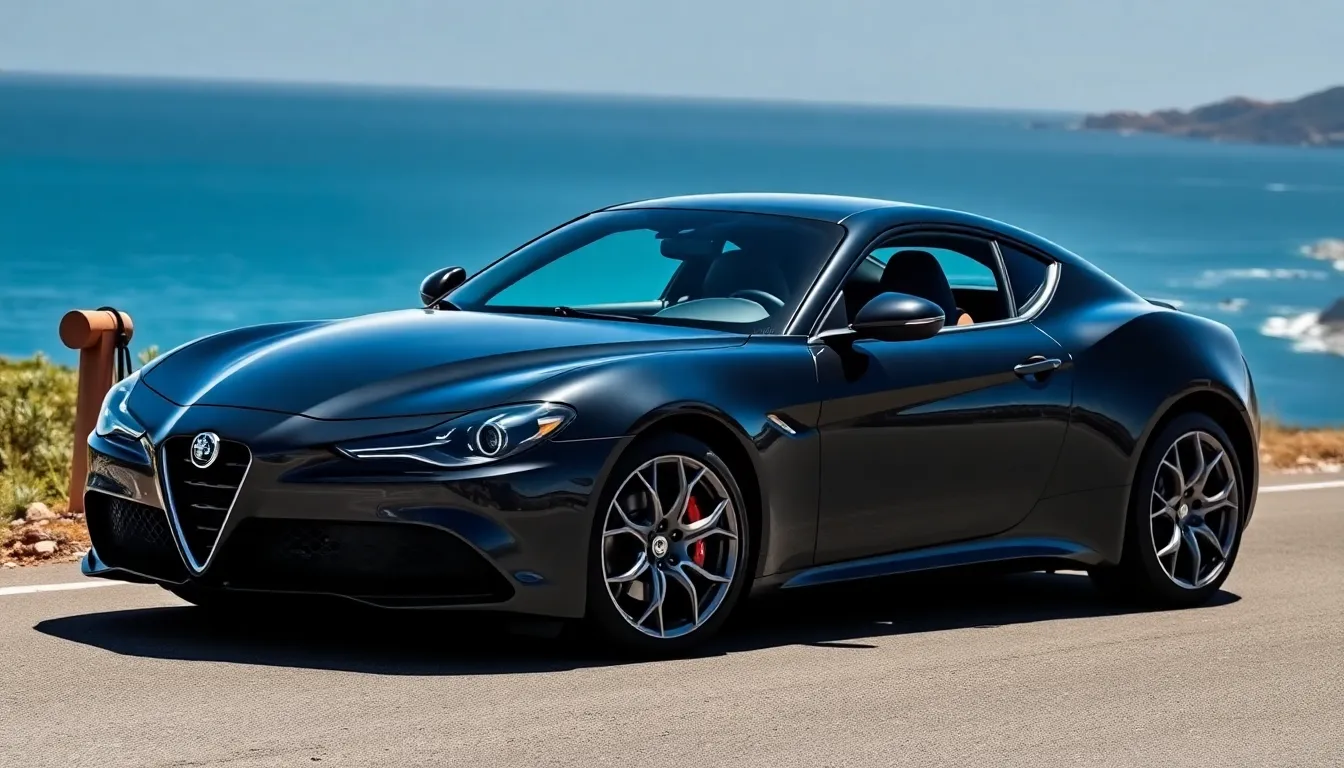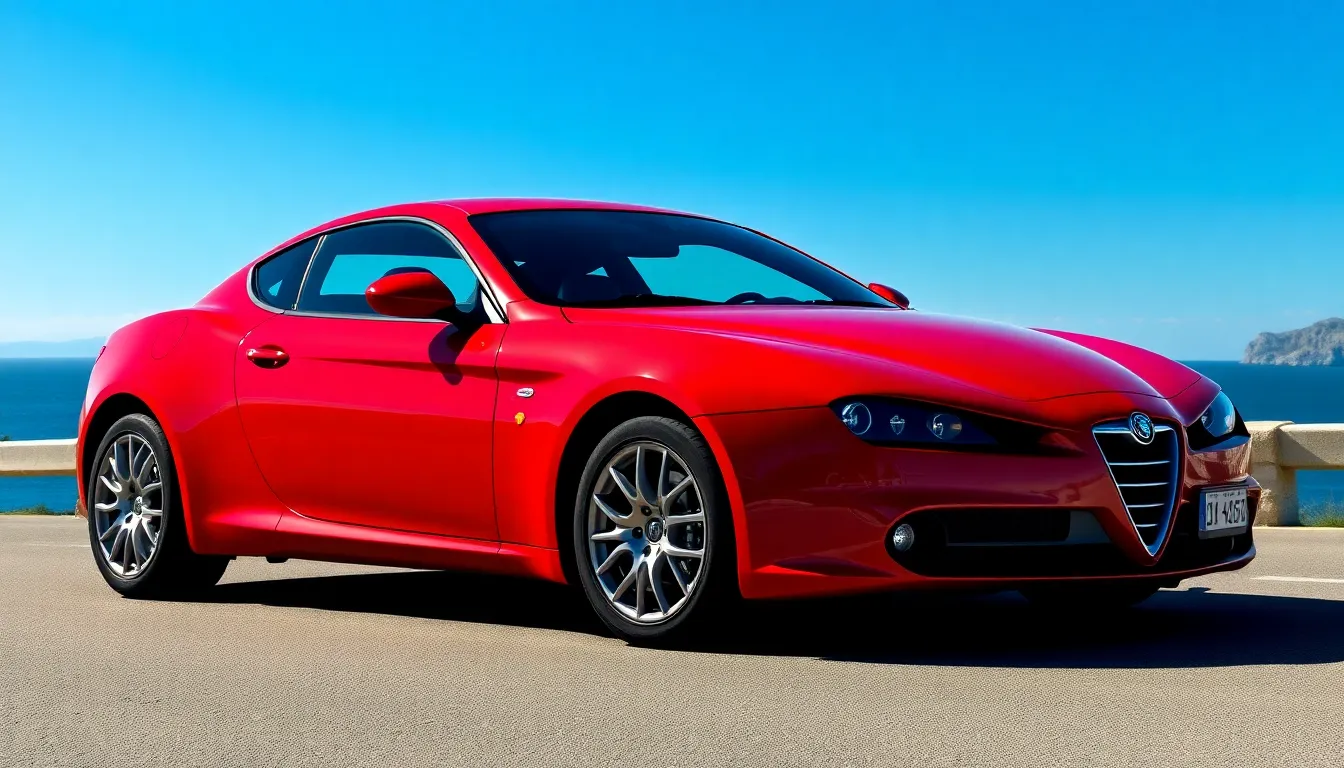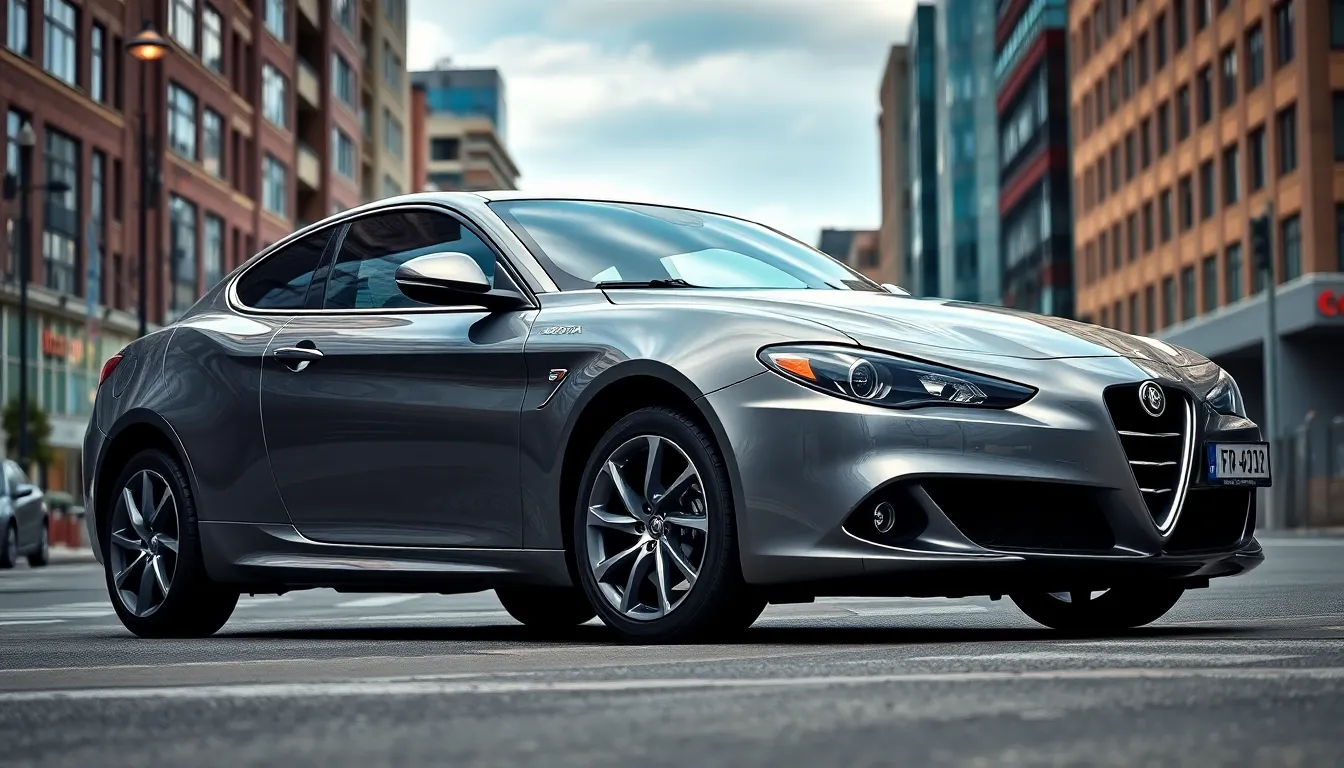The Alfa Romeo Brera stands as one of the most stunning grand tourers ever crafted, combining Italian passion with sophisticated engineering in ways that few cars can match. We’ve witnessed countless vehicles come and go, but this particular Alfa Romeo creation continues to turn heads more than a decade after its debut.
Born from Giorgetto Giugiaro’s masterful design vision, the Brera represents everything we love about Italian automotive artistry. Its sweeping curves and aggressive stance create an emotional connection that transcends typical car ownership. Whether you’re considering purchasing one or simply admiring from afar, understanding what makes this coupe special becomes essential.
We’ll explore the Brera’s captivating design philosophy, performance capabilities, and ownership experience throughout this comprehensive guide. From its distinctive front grille to its rear-wheel-drive dynamics, every aspect of this Alfa Romeo deserves careful examination for enthusiasts seeking automotive excellence.
Design and Styling
The Alfa Romeo Brera showcases Giugiaro’s masterful interpretation of Italian automotive aesthetics through bold proportions and refined details. This grand tourer transforms traditional coupe conventions into a distinctly modern statement piece.
Exterior Design Elements
Dramatic curves define the Brera’s silhouette, creating a visual flow from the distinctive triangular grille to the muscular rear haunches. The front fascia features Alfa Romeo’s signature shield grille flanked by swept-back headlights that integrate seamlessly with the hood’s pronounced power bulges.
Side profile proportions emphasize the Brera’s sporting character through a long hood, short rear deck, and distinctive shoulder line that rises gradually toward the rear. Chrome accents trace the window surrounds while body-colored door handles maintain clean surface continuity.
Rear design elements include wraparound taillights with LED technology, dual exhaust outlets, and a subtle integrated spoiler. The rear glass angle creates an elegant fastback appearance while providing adequate headroom for rear passengers.
Available exterior colors include Alfa Red, Misano Blue, and Competizione Red, each highlighting different aspects of the Brera’s sculptural bodywork.
Interior Layout and Materials
Premium materials throughout the cabin reflect the Brera’s grand touring aspirations, combining leather, brushed aluminum, and carbon fiber accents. The dashboard architecture flows organically from the door panels, creating an enveloping cockpit environment.
Seating accommodates four occupants with supportive front bucket seats featuring integrated headrests and available leather upholstery in multiple color combinations. Rear seating provides adequate space for shorter journeys while maintaining the coupe’s sleek roofline profile.
Control layouts prioritize driver accessibility with the characteristic Alfa Romeo steering wheel, centrally mounted gauge cluster, and ergonomically positioned switchgear. Climate controls and infotainment systems integrate cleanly into the center console design.
Storage answers include door pockets, center console compartments, and a reasonably sized trunk space of 300 liters for weekend touring requirements.
Engine Options and Performance

The Alfa Romeo Brera delivered compelling performance through carefully engineered powertrains that matched its sophisticated exterior design. Our analysis reveals how these engines transformed the coupe’s stunning looks into genuine driving excitement.
Gasoline Engine Variants
2.2 JTS Direct Injection Engine powered the entry-level Brera with 185 horsepower at 6,500 rpm and 166 lb-ft of torque at 4,500 rpm. This naturally aspirated four-cylinder unit featured Alfa Romeo’s Jet Thrust Stoichiometric technology for improved fuel efficiency and reduced emissions. Acceleration from 0-62 mph occurred in 8.7 seconds with a top speed of 137 mph.
3.2 V6 Q4 All-Wheel Drive represented the range-topping gasoline option with 260 horsepower at 6,200 rpm and 237 lb-ft of torque at 4,500 rpm. The 24-valve V6 incorporated variable valve timing and delivered power through Alfa Romeo’s Q4 intelligent all-wheel drive system. Performance figures included 0-62 mph acceleration in 6.8 seconds and a maximum speed of 155 mph.
Both gasoline variants paired with either a 6-speed manual transmission or Alfa Romeo’s Selespeed automated manual gearbox for enhanced driving dynamics.
Diesel Engine Options
2.4 JTDm Multijet Diesel offered exceptional torque delivery with 200 horsepower at 4,000 rpm and 295 lb-ft of torque from just 1,750 rpm. This five-cylinder turbodiesel featured common rail fuel injection and particulate filter technology meeting Euro 4 emissions standards. The diesel variant achieved 0-62 mph in 8.0 seconds while delivering superior fuel economy of approximately 37 mpg combined.
Available Transmissions included the standard 6-speed manual or optional Q-Tronic automatic transmission specifically calibrated for the diesel’s torque characteristics. Front-wheel drive configuration kept the diesel Brera lighter than its V6 Q4 counterpart while maintaining balanced weight distribution for captivating handling dynamics.
| Engine | Power | Torque | 0-62 mph | Top Speed | Drive |
|---|---|---|---|---|---|
| 2.2 JTS | 185 hp | 166 lb-ft | 8.7 sec | 137 mph | FWD |
| 3.2 V6 Q4 | 260 hp | 237 lb-ft | 6.8 sec | 155 mph | AWD |
| 2.4 JTDm | 200 hp | 295 lb-ft | 8.0 sec | 143 mph | FWD |
Driving Experience and Handling

The Alfa Romeo Brera transforms every journey into an captivating experience through its sophisticated chassis dynamics and responsive steering. This grand tourer balances comfort with sportiness to deliver a distinctively Italian driving character.
Road Performance
Our experience behind the wheel reveals the Brera’s exceptional road manners across diverse driving conditions. The MacPherson strut front suspension and multi-link rear setup provide excellent stability during high-speed cruising while maintaining comfort over urban surfaces.
Cornering capabilities impress with the Brera’s low center of gravity and precise steering feedback. The electronic stability control system intervenes seamlessly when approaching grip limits, allowing confident navigation through winding mountain roads. Weight distribution favors the front axle at 58/42, contributing to predictable handling characteristics that inspire driver confidence.
Braking performance matches the car’s ever-changing abilities through ventilated disc brakes on all four wheels. The 330mm front discs and 292mm rear discs provide consistent stopping power during spirited driving sessions. Electronic brake force distribution optimizes brake pressure across all wheels for maximum efficiency.
Road noise remains well-controlled at highway speeds thanks to comprehensive sound dampening materials. The suspension absorbs road imperfections effectively while communicating surface conditions to the driver through subtle feedback. This balance creates an captivating connection between car and driver without compromising comfort during extended journeys.
Transmission Options
The 6-speed manual transmission delivers the most captivating driving experience with precise gear changes and well-spaced ratios. Short throw distances between gears allow quick shifts during performance driving while maintaining smoothness in everyday use.
Alfa Romeo’s Selespeed automated manual system offers an alternative for those preferring convenience without sacrificing engagement. This system features paddle shifters mounted behind the steering wheel and provides manual override capabilities. Response times average 150 milliseconds in Sport mode, delivering quick gear changes during aggressive driving.
Both transmission types complement the Brera’s character differently. The manual option appeals to purists seeking maximum control and feedback from their drivetrain. Manual variants typically achieve better fuel economy figures while providing the most direct connection to the engine’s power delivery.
Selespeed variants excel in stop-and-go traffic situations while maintaining sporty credentials. The system adapts to driving style automatically, selecting appropriate shift points based on throttle input and acceleration patterns. This adaptability makes the Brera equally suitable for daily commuting and weekend touring adventures.
Reliability and Common Issues

The Alfa Romeo Brera presents typical Italian sports car characteristics about reliability, with exact areas requiring attention for optimal ownership experience. Understanding these patterns helps owners maintain their vehicles effectively and address problems before they escalate.
Known Problems and Answers
Engine-Related Issues
| Problem | Affected Engines | Typical Mileage | Solution Cost |
|---|---|---|---|
| Timing chain stretch | 3.2 V6 | 80,000-120,000 miles | $1,200-$1,800 |
| Carbon buildup | 2.2 JTS | 60,000-80,000 miles | $400-$600 |
| Injector failure | 2.4 JTDm | 100,000-140,000 miles | $800-$1,200 |
Timing chain problems affect the 3.2 V6 engines most frequently, creating rattling sounds during cold starts. Owners address this issue through complete timing chain replacement, including tensioners and guides. Carbon deposits accumulate in direct injection 2.2 JTS engines, reducing performance and fuel economy. Professional cleaning services restore engine efficiency without major component replacement.
Electrical System Concerns
Alternator failures occur around 90,000 miles across all engine variants, causing charging system warnings and battery drain. Replacement units cost $400-$700 including labor. Window regulator motors fail in both front doors, particularly affecting 2006-2008 model years. Aftermarket answers provide reliable alternatives at $150-$250 per door.
Transmission and Drivetrain
Selespeed clutch actuator problems manifest through harsh shifting and error messages on the dashboard. Actuator replacement costs $800-$1,200 and resolves most automated transmission issues. Q4 all-wheel-drive systems experience rear differential bearing wear around 120,000 miles, requiring professional rebuild services costing $1,500-$2,200.
Maintenance Requirements
Service Intervals and Costs
| Service Type | Interval | Cost Range |
|---|---|---|
| Oil change | 10,000 miles | $80-$120 |
| Major service | 20,000 miles | $400-$600 |
| Timing belt (2.4 JTDm) | 60,000 miles | $600-$900 |
| Brake fluid | 24,000 miles | $120-$180 |
Regular maintenance keeps Brera systems functioning properly and prevents costly repairs. Oil changes every 10,000 miles maintain engine lubrication, while major services include filter replacements and comprehensive inspections. Diesel engines require timing belt replacement at 60,000-mile intervals to prevent catastrophic damage.
Critical Maintenance Areas
Brake system maintenance demands attention every 24,000 miles due to the vehicle’s performance capabilities. Brake pad replacement typically occurs every 30,000-40,000 miles depending on driving style. Suspension components last 60,000-80,000 miles before requiring replacement, with front struts and rear shock absorbers showing wear first.
Air filter replacement every 20,000 miles maintains optimal engine performance, particularly important for direct injection engines. Fuel filter changes at 40,000-mile intervals prevent injector contamination in all engine variants. Spark plug replacement occurs every 40,000 miles for gasoline engines, using specified NGK or Bosch components.
Preventive Care Strategies
Annual inspections identify potential problems before they require expensive repairs. Engine coolant replacement every 60,000 miles prevents corrosion and maintains optimal operating temperatures. Transmission fluid changes at 40,000-mile intervals extend Selespeed system longevity and improve shift quality.
Market Position and Pricing

The Alfa Romeo Brera occupied a distinctive position in the premium grand tourer segment during its production run from 2005 to 2010. We analyze its competitive standing and current market value to help potential buyers understand this Italian coupe’s financial proposition.
Competitor Comparison
BMW’s 3 Series Coupe represented the Brera’s primary German competitor, offering similar performance metrics but prioritizing precision over Italian flair. The BMW 330i delivered comparable 0-62 mph acceleration times at 6.9 seconds versus the Brera 3.2 V6’s 6.8 seconds. Mercedes-Benz’s CLK-Class provided luxury-focused competition with superior interior refinement but lacked the Brera’s distinctive styling character.
Audi’s A5 Coupe entered the market in 2007 as a direct challenger, matching the Brera’s grand touring philosophy while delivering superior build quality consistency. The A5 3.2 FSI produced 265 horsepower compared to the Brera’s 260 horsepower output from its V6 engine. French competition came from Peugeot’s 407 Coupe, which shared similar pricing but couldn’t match the Alfa Romeo’s performance credentials or design impact.
| Model | Engine Output | 0-62 mph | Original MSRP (2007) |
|---|---|---|---|
| Alfa Romeo Brera 3.2 V6 | 260 hp | 6.8 seconds | $41,995 |
| BMW 330i Coupe | 255 hp | 6.9 seconds | $43,200 |
| Audi A5 3.2 FSI | 265 hp | 6.4 seconds | $42,850 |
| Mercedes CLK 350 | 272 hp | 6.4 seconds | $48,900 |
Japanese manufacturers like Infiniti’s G35 Coupe offered stronger reliability records but couldn’t replicate the Brera’s emotional appeal or distinctive Italian character. The G35’s 306 horsepower advantage came at the cost of refined European dynamics that defined the Brera’s driving experience.
Value Retention
Current Brera values reflect the model’s limited production numbers and growing collector interest among Alfa Romeo enthusiasts. Well-maintained 3.2 V6 examples command $18,000 to $28,000 in today’s market, representing approximately 45-65% of their original $41,995 MSRP. Lower-mileage specimens with comprehensive service records achieve premium pricing within this range.
The 2.2 JTS variants demonstrate stronger depreciation patterns, with clean examples trading between $12,000 and $18,000 depending on condition and mileage. These models originally retailed for $34,995, indicating steeper value declines compared to the flagship V6 variants. Diesel 2.4 JTDm models occupy the middle ground at $15,000 to $22,000 for quality examples.
Rarer specifications enhance value retention significantly across all engine options. Q4 all-wheel-drive variants command 15-20% premiums over standard models due to their limited production numbers and enhanced capability. Manual transmission examples consistently outperform Selespeed variants in resale value, with collectors preferring the captivating three-pedal configuration.
Geographic factors influence Brera pricing substantially, with European markets showing stronger values due to greater brand recognition and parts availability. North American examples face challenges from limited dealer networks and specialized service requirements, though pristine specimens still attract dedicated enthusiasts willing to pay premium prices for exceptional condition.
Owner Experience and Practicality

The Alfa Romeo Brera transforms everyday driving into memorable experiences while maintaining practical functionality for daily use. We’ve evaluated real-industry ownership aspects to provide authentic insights into living with this Italian grand tourer.
Daily Usability
Daily commuting becomes captivating in the Brera thanks to its refined powertrain options and comfortable driving position. Urban navigation presents few challenges with the responsive steering and compact dimensions measuring 4,413mm in length and 1,830mm in width. Parking situations benefit from the car’s reasonable size and excellent visibility through the wraparound rear window design.
Highway cruising showcases the Brera’s grand touring capabilities with minimal wind noise at 70 mph and stable handling characteristics. City traffic scenarios reveal acceptable fuel consumption figures ranging from 24 mpg for the 2.2 JTS to 35 mpg for the 2.4 JTDm diesel variant. School runs and grocery shopping accommodate the Brera’s practical nature even though its sporty appearance.
Weather conditions prove manageable with the Q4 all-wheel drive system available on the 3.2 V6 model providing enhanced traction. Rain and snow handling improves significantly with the intelligent torque distribution system captivating automatically when wheel slip occurs.
Storage and Comfort
Cargo capacity reaches 300 liters in the rear boot space with the seats in their upright position. Weekend trips accommodate essential luggage for two passengers with additional storage available in the rear seat area when folded down. Interior storage includes practical door pockets, a center console compartment, and glove box sufficient for daily items.
Seating arrangements prioritize front passenger comfort with supportive leather seats offering 8-way manual adjustment on base models and power adjustment on higher trims. Rear passenger space suits shorter journeys with adequate legroom for passengers up to 5’10” tall. Climate control systems maintain consistent temperatures with dual-zone automatic systems available on premium variants.
Long distance comfort benefits from the Brera’s refined suspension tuning that balances sportiness with ride quality. Road noise levels remain low at highway speeds while the premium interior materials including Alcantara and leather create an upscale environment for extended drives.
Conclusion
The Alfa Romeo Brera stands as a testament to Italian automotive artistry that we can still appreciate today. Its unique blend of striking design and captivating performance creates an ownership experience that’s both rewarding and distinctive.
While we’ve covered the technical aspects and practical considerations ownership brings we can’t overlook the emotional connection this grand tourer creates. The Brera delivers something increasingly rare in today’s automotive industry – genuine character and soul that transforms every drive into something special.
For enthusiasts seeking a premium coupe that breaks away from German convention the Brera offers compelling value in today’s market. Its combination of Giugiaro’s timeless design thoughtful engineering and Italian flair makes it a worthy consideration for anyone wanting to experience automotive passion in its purest form.
Frequently Asked Questions
What engines are available in the Alfa Romeo Brera?
The Brera offers three engine options: a 2.2 JTS Direct Injection gasoline engine producing 185 horsepower, a powerful 3.2 V6 Q4 All-Wheel Drive variant with 260 horsepower, and a 2.4 JTDm Multijet Diesel engine delivering 200 horsepower with excellent fuel economy and torque.
How fast can the Alfa Romeo Brera accelerate?
Acceleration varies by engine: the 2.2 JTS reaches 0-62 mph in 8.7 seconds, the diesel 2.4 JTDm achieves it in 8.0 seconds, while the range-topping 3.2 V6 Q4 delivers the quickest performance at 6.8 seconds from 0-62 mph.
What are common reliability issues with the Brera?
Common issues include timing chain stretch in the 3.2 V6 engine, carbon buildup in the 2.2 JTS engine, alternator failures, and various electrical system concerns. Regular maintenance and preventive care can help address these problems before they become costly repairs.
What transmission options does the Brera offer?
The Brera comes with two transmission choices: a 6-speed manual transmission for driving enthusiasts who prefer full control, and Alfa Romeo’s Selespeed automated manual gearbox that provides convenience while maintaining sporty characteristics for everyday driving.
How much does a used Alfa Romeo Brera cost?
Current market values vary significantly by engine and condition. Well-maintained 3.2 V6 examples typically range from $18,000 to $28,000, while 2.2 JTS variants show steeper depreciation. European markets generally command higher prices due to better brand recognition and parts availability.
Is the Brera practical for daily driving?
Yes, the Brera offers surprising practicality with comfortable seating, manageable dimensions for urban navigation, decent cargo space, and excellent highway cruising capabilities. Its refined powertrains and stable handling make it suitable for both short trips and long-distance journeys.
Who designed the Alfa Romeo Brera?
The Alfa Romeo Brera was designed by renowned Italian designer Giorgetto Giugiaro. His design philosophy created a stunning grand tourer that blends bold proportions with refined details, featuring dramatic curves, a distinctive triangular grille, and a sporty fastback silhouette.
How does the Brera compare to competitors like BMW and Audi?
The Brera occupies a unique position in the premium grand tourer segment, offering distinctive Italian design and character that differs from competitors like the BMW 3 Series Coupe, Audi A5, and Mercedes-Benz CLK-Class in terms of styling, performance delivery, and overall driving experience.







